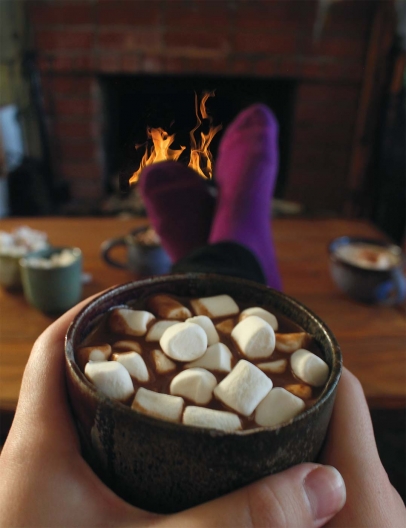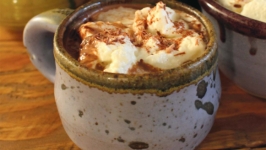A Warm Cup of Comfort
Maybe, like me, you grew up with the flavor pack of hot chocolate by some national brand, six to a box, ready to be stirred into hot water or (for a creamy variation) hot milk. Hot chocolate symbolized cold weather—in the Midwest of my youth snow days were a real thing—and toes toasted over the floor heater. After I moved to the valleys of California, where snow on the tops of distant mountains is the winter view for hardly more than a minute, hot chocolate became just a comfort food to sip on the occasional cool night.
I didn’t come close to knowing the history of hot chocolate, or even how to properly make it, until well into my adulthood. Now, the question becomes: Is hot chocolate another culturally appropriated food?
BITTERSWEET HISTORY
Chocolate, in its earliest known processed form, appeared as an unsweetened drink, probably primarily used as medicine or in ceremony, in the Mayan and Aztec cultures. It was likely not served hot, was made with water and local spices, and was frothed by pouring back and forth between cups. According to some sources, the indigenous people used chocolate as a form of currency as well as offerings in religious rituals.
It was not a global phenomenon until after the Spanish conquest of South America, and would likely have been disregarded as too bitter by the Spaniards but for the importance chocolate played in the culture of the natives. Eventually, in the late 1500s or early 1600s, the unsweetened chocolate drink was sent to Western Europe, where Spanish monks are credited as being the first to add sugar. From there, through trade, time and experimentation, it took on a variety of iterations, each a reflection of the culture that adopted it.
LATIN AMERICAN HOT CHOCOLATES
In Latin America chocolate consists of a wide variety of hot and iced chocolate drinks, with hundreds of recipes dependent on region or even family. According to the Smithsonian and Mission Chocolate, in Mexico, Central America, Ecuador, Colombia and Peru the drinks are usually made from unrefined cacao; cracking, hulling and using grinding and frothing tools are part of the process. Though the historic drink was just ground cacao beans with lukewarm water and achiote (ground annatto seed), ground corn or vanilla, the most common drink in those regions now—generally known in North America as Mexican Hot Chocolate—refers to a hot sugar-sweetened version with milk and spices like Ceylon cinnamon, anise, nuts and seeds ground with the cacao and frothed with a molinillo (a wooden whisk made specifically for frothing the chocolate drink).
The version more common in countries like Brazil, Uruguay, Argentina, Chile and Paraguay doesn’t use the unrefined cacao, but instead incorporates melted chocolate chips or chocolate bars, making it a smoother texture.
GLOBAL HOT CHOCOLATE
There are as many variations of the chocolate drink in Europe as there are cultures, but these are some of the more popular or well known.
Spanish
Often served as breakfast with churros on the side, in Spain hot chocolate—made with ground cacao, cocoa powder or solid chocolate—is more like the consistency of pudding, a thickened sauce better for dipping than sipping.
Italian
Another thicker sipper, the Italian dark chocolate cioccolata calda is often made with cornstarch or flour as a thickener and served very hot.
French
Le chocolat chaud is the iconic rich sipping chocolate made with shaved dark chocolate, cream, whole milk and sugar. A little goes a long way.
Hungarian
This hot chocolate carries a unique flavor with chopped chocolate, smoked paprika, pepper, ground cloves and sometimes a touch of salt and burnt sugar.
The Netherlands
Dutch cocoa typically has lower acid due to the addition of an alkaline agent in the chocolate-making process, giving it a slightly less bitter flavor. Dutch hot chocolate is made with rich dark chocolate, a nice scoop of Dutch processed cocoa, milk and a large dollop of unsweetened whipped cream dusted with cocoa and cinnamon. For adults, a touch of rum is often added.
Belgian
Made with both ultra-smooth chopped milk chocolate and dark chocolate, milk, cinnamon, sugar and whipped cream, this hot chocolate celebrates the high-quality chocolate for which Belgium is known.
Viennese
Truly indulgent, hot chocolate in Vienna is made with water instead of milk, bittersweet chocolate shavings, thickened with egg yolk and often served with a heaping serving of whipped cream.
Indian
Hot chocolate in India heavily incorporates the earthy spices—like ginger, cardamom, cinnamon, cloves and peppercorn—that are so prevalent in the region, but uses white chocolate as a base.
- National Hot Chocolate Day is Jan. 31. Feel free to celebrate with our recipe or with one of these global flavors.

Chocolate comes from the cacao tree, native to the tropics of the Americas, grown now around the world in tropical climate zones 11–13. The scientific name, Theobroma, means “food of the gods” and has been seen as such for centuries. Cacao beans grow inside large pods covered by a white sticky sweet pulp that can be eaten fresh. The beans are harvested, fermented and then dried (in the sun for the best results) before being roasted and ground into chocolate.
Cacao can be grown in Ventura County but will only survive the winters if in a temperature-controlled greenhouse. Pods are produced from 4- to 7-year-old trees, so it is a long-term project. Chocolate can be made at home from unroasted bean to bar with minimal equipment, but if sourcing raw cacao, it is important to buy from reputable vendors like Meridian Cacao Co. (www.MeridianCacao.com) or The Chocolate Alchemist (www.ChocolateAlchemy.com), who buy direct and pay the farmers well.






